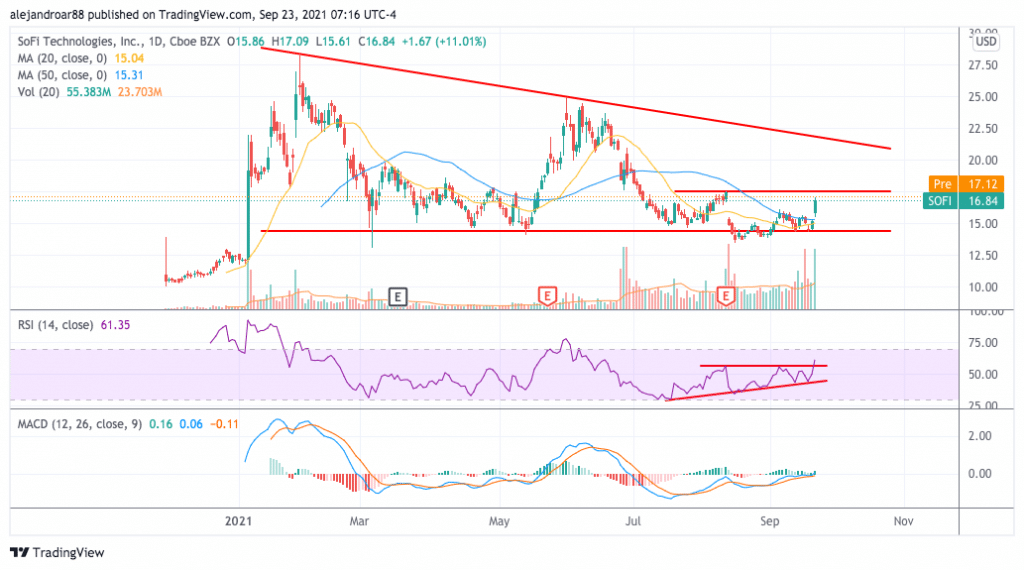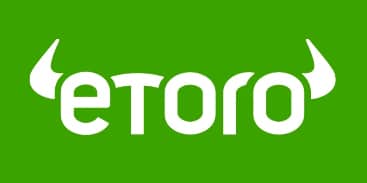SoFi Stock Up 18% in September – Time to Buy SOFI Stock?
Please note that we are not authorised to provide any investment advice. The content on this page is for information purposes only.
The price of SoFi stock has gone up 18% so far in September and have fully recovered from the hit it took back in mid-August when the company reported a wider-than-expected adjusted net loss per share of $0.48 for its second fiscal quarter of 2021 compared to $0.03 per share the financial technology firm had shed during the same period a year ago.
Most of this monthly advance occurred yesterday as SoFi stock rose more than 11% at $16.84 per share after an analyst from Jefferies Financial Group initiated coverage on the stock and rated it a buy with a price target of $25 for the next 12 months.
Such a forecast resulted in a 64.5% potential upside for the stock based on its 21 September closing price. This would be the fourth bullish recommendation SoFi Technologies has received including three other buy ratings extended by Mizuho, Rosenblatt Securities, and Oppenheimer. Meanwhile, Jefferies price target would be the second highest behind Rosenblatt’s $30 forecast.
According to Jefferies’ analyst, SoFi could swing to GAAP profitability in the next three years while its “synergistic business model” may help the company in generating further user growth, margin expansion, and product adoption in the future.
Can these positive ratings keep lifting SoFi stock near those $20 – $30 targets? In the following article, I’ll discuss the latest price action along with assessing the fundamentals of the company to possibly answer that question.
67% of all retail investor accounts lose money when trading CFDs with this provider.
SoFi Stock – Technical Analysis

Yesterday’s uptick pushed the price of SoFi stock above its short-term moving averages while it resulted in a definite bounce above the $14.5 support area.
Trading volumes were quite high during the session as they exceeded the 10-day average by more than two times. This reflects the impact of this pad in the back from Jefferies to the company backed by the well-known venture capitalist Chamath Palihapitiya.
Meanwhile, momentum oscillators including the Relative Strength Index (RSI) are sending potential buy signals with the latter posting a higher high despite the price not yet crossing the $17.5 resistance highlighted in the chart.
What this indicates is that positive momentum is accelerating for SoFi Invest and that view is reinforced by increasingly positive histogram readings in the MACD as well.
Moving forward, a jump above $17.5 could be a definite signal that a fresh bullish cycle is about to start. If that is the case, the next target for SoFi would be around $21 per share. This would result in a third tag of SoFi’s upper trend line (highlighted above) and closer to analysts’ 12-month forecasts.
SoFi Stock – Fundamental Analysis
SoFi considers itself an all-in-one money management digital solution where users can enjoy most of the services they would typically get from a traditional financial institution but hassle-free.
SoFi’s member base has been growing rapidly from a total of 704,000 users back in Q1 2019 to 2.56 million by the end of the last quarter. Meanwhile, from 2018 to 2020 total adjusted revenues for SoFi have moved from $240.7 million to $621.2 million primarily coming from SoFi’s lending activities.
The company has also been progressively trimming its negative adjusted EBITDA from around $226 million back in 2018 to $44.58 million. In percentage terms, this results in a significant improvement from a negative adjusted EBITDA margin of 94% to minus 7% by the end of the 2020 fiscal year.
For the end of this upcoming 2021 fiscal year, SoFi is expecting to see its annual adjusted revenues jump to $980 million resulting in a 58% year-on-year jump while its adjusted EBITDA margin should swing to positive territory to around 3%.
SoFi’s business seems to be maturing to a point that it can start delivering positive bottom-line profitability for investors in the near future – an opinion that Jefferies analysts seem to share.
At its current market capitalization of $13.4 billion, SoFi is being valued at 13.7 times its forecasted sales for 2021 and at hundreds of times its forecasted adjusted EBITDA for the same period.
This valuation seems to be anticipating a significant acceleration in the company’s top-line growth that should be accompanied by an improvement in SoFi’s bottom-line margins via economies of scale.
Since SoFi is an all-in-one ecosystem, market participants appear to be expecting that average revenues per user (ARPU) should continue to advance as a result of more products and services being introduced by SoFi to serve its growing user base.
Each SoFi user is being valued at the moment at around $5,200 even though they are only bringing around $383 in revenues per year. Based on these variables, SoFi’s valuation seems to be a bit stretched despite what analysts currently believe as the company would have to significantly expand its ARPUs to justify its price tag.






